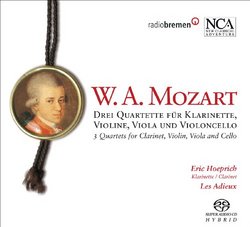| All Artists: Mozart, Ensemble Les Adieux, Hoeprich Title: 3 Quartets for Clarinet Violin Viola & Cello Members Wishing: 0 Total Copies: 0 Label: New Classical Advt. Original Release Date: 1/1/2010 Re-Release Date: 2/23/2010 Album Type: Hybrid SACD - DSD Genre: Classical Styles: Historical Periods, Classical (c.1770-1830) Number of Discs: 1 SwapaCD Credits: 1 UPC: 885150601723 |
Search - Mozart, Ensemble Les Adieux, Hoeprich :: 3 Quartets for Clarinet Violin Viola & Cello
 | Mozart, Ensemble Les Adieux, Hoeprich 3 Quartets for Clarinet Violin Viola & Cello Genre: Classical |
Larger Image |
CD Details |
CD ReviewsIf you ever wished Mozart left behind more works for the cla Berna Can | New York, NY | 03/24/2010 (4 out of 5 stars) "These three quartets sound oddly familiar yet somehow peculiar until one realizes that they are actually transcriptions of Mozart's violin sonatas (K. 317d & 374f) and his piano trio in G major. The pieces are rarely recorded in their incarnation for clarinet, perhaps because they are (almost certainly) not transcriptions from the composer's pen, and appeared in print in 1799, a few years after Mozart's death. However that may be, the music feels completely at home in its new instrumentation, with several instances, especially in the slow middle movements of all three quartets and the first movement of the quartet in F major, gaining in poignancy from the clarinet's subtly melancholy character and soaring quality.
Erich Hoeprich is justly a leading name among period-instrument clarinetists. He coaxes a smooth, flexible and expressive tone from his instruments, whether interpreting Mozart's impish and playful moods, or more hauntingly mournful moments. Hoeprich is also apparently a jack-of-all-trades; in addition to performing, teaching, and writing scholarly articles about the historical clarinet, he is a maker of clarinets modeled on original instruments. In this recording, Hoeprich uses a clarinet in B that he has made after a model by H. Genser in the first two quartets; for the third quartet, he uses a period clarinet in C by Genser himself. The clarinets used in this recording sound rounder and more full-bodied, and have softer edges, especially noticeable in the lower register, than their modern counterparts, Les Adieux's string players also use original instruments from the eighteenth century, which imparts a greater transparency to the textures. This vibrant, committed performance throws new light on relatively familiar Mozart chamber works. " |
